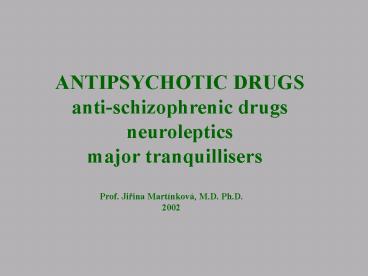Bez nadpisu - PowerPoint PPT Presentation
1 / 12
Title:
Bez nadpisu
Description:
organic psychoses (mental disturbances caused by head injury, alcoholism, or ... increased intraocular pression. dry mouth and eyes. constipation. urinary retention ... – PowerPoint PPT presentation
Number of Views:44
Avg rating:3.0/5.0
Title: Bez nadpisu
1
ANTIPSYCHOTIC DRUGS anti-schizophrenic
drugs neuroleptics major tranquillisers
Prof. Jirina Martínková, M.D. Ph.D. 2002
2
- The most important types of psychoses are
- schizophrenia
- affective disorders (depression, mania)
- organic psychoses (mental disturbances caused by
head injury, alcoholism, or other kind of organic
disease)
3
- The nature of schizophrenia
- psychotic illness characterised by delusions,
- hallucinations and thought disorder
- - positive symptoms
- and flattening of emotional responses -
- - negative symptoms
- its incidence is about 1 of population with a
strong - hereditary component
- pharmacological evidence is generaly consistent
with - dopamine overactivity theory.
- According to dopamine theory in schizophrenics
- hyperactivity of dopamine at D2 receptors in
limbic - system occurs.
4
pharmacodynamics of antipsychotics 1.
Antipsychotic effects (against positive and
negative symptoms) generaly run parallel
to action on D2receptors (blockade of
postsynaptic D2 receptors) but other other
blocking action may be seen other receptors
are blocked 5-HT2 a.1 Hi1 M unwanted
effects Antipsychotics take days or weeks to
work, 2. Decrease in aggressivity this
effect can be produced immediately
chlorpromazine was the first 1947
5
(No Transcript)
6
pharmacokinetics of antipsychotics t1/2 of most
antipsychotics is 15-30 hours Most drugs can be
given orally or by i.m. injection, once or twice
a day. Slow- release preparations for many are
available, in which the active drug is esterified
with heptanoic or decanoic acid and dissolved in
oil. Given as an i.m. inj., the drug acts for 2-4
weeks. These preparations are used as a means of
overcoming compliance problems CL depends
entirely on hepatic transformation by a
combination of oxidative and conjugative
reactions
7
- Classification of antipsychotic drugs
- typical antipsychotics
- chlorpromazine, fluphenazine, thioridazine
- haloperidol, flupenthixol, clopenthixol
- atypical antipsychotics
- clozapine, risperidone, sulpiride, olanzapine
- Distinction in atypical antipsychotics
- incidence of extrapyramidal unwanted effects is
less - efficacy againt negative symptoms
- efficacy in treatment-resistant group of
patients
8
- Unwanted effects
- TYPE A- predictable
- extrapyramidal motor disturbances
- result from D2 receptor blockade in the
nigrostriatal pathways - acute (reversible) Parkinson-like symptoms
(tremor, rigidity) - acute dystonias
(muscle spasm, protruding -
tongue) - slowly developing (often irreversible) tardive
dyskinesia - (involuntary movements of face
and limbs appearing after months or years of
antipsychotic treatment). - It may be associated with proliferation of
dopamine receptors (possibly presynaptic) in
corpus striatum. - Incidence is less with atypical antipsychotics,
and particular low with clozapine
9
Mechanisms of EPS
Dopamine (-)
cholinergic pathway ()
S. NIGRA
CORPUS STRIATUM
GABA (-)
10
sedation occurs with many antipsychotics
antihistamine H1activity contributes to their
sedative action antimuscarinic activity
blurring of vision increased
intraocular pression dry mouth and
eyes constipation urinary
retention orthostatic hypotension results
from a-adrenoreceptors blocking weight gain
probably related to 5-HT antagonism
11
TYPE B- unpredictable jaundice (with
older drugs) usually mild, and of obstructive
origin, and disappears quickly when the
drug is stopped leukopenia and
agranulocytosis rare but potentially fatal
(clozapine, whose use therefore
requires regular monitoring of blood cell
counts) urticarial skin reactions and excessive
sensitivity to ultraviolet light neuroleptic
malignant syndrome muscle rigidity is
accompanied by a rapid rise in body
temperature and mental confusion. It is usually
reversible, but death from renal or
cardiovascular failure occurs in 10-20 of
cases
12
- IND
- treatment of schizophrenia
- and acute behavioural emergencies
- long-term treatment is often effective in
preventing recurrence of
schizophrenic attacks, and is a major factor in
allowing schizophrenic patients to lead normal
lives - depot preparations are often used for
maintenance therapy - atypical antipsychotics are effective in
improving negative symptoms - approximately 40 of chronic schizophrenic
patients are poorly controlled by antipsychotic
drugs. Clozapine may be effective in some of
these antipsychotic-resistant cases































